There's a lot of scientific information available about daylilies that have been tested for performance with Rust, and also some for Spring Sickness. Keep in mind that a rating of "resistant" does not mean a cultivar will not get these diseases. "Resistant" only means that they were observed to get 50% or less of their foliage affected with those diseases, and thus performed well enough to be considered acceptable garden and helpful breeding specimens. Resistant cultivars were seen to self-recover without any treatment and were found to be presentable for garden display with foliage trimmed to remove (and discard) affected leaves.
Averaged Rust rankings can be found for individual cultivars in the ATP database here.
Or, you can search for all ranked cultivars in the Search by Characteristics page here.
More information about the sources of the scores is here.
Scores for cultivars that were evaluated for Spring Sickness are linked at the bottom of the post shown: here.
Additionally, listed below are some of my own daylily recommendations for cultivars that have been tested, or have lineages that show testing, for both rust and spring sickness. Recommendations come from a non-commercial, home hobby-hybridizing garden in a coastal state with temps ranging from 25-105 degrees, marine and desert/sandy soil, and low rainfall.
I'll update recommendations over time, so you are welcome to check back to see more listings, and feel free to send a tree-mail if you have questions or feedback about any of the daylilies listed. I'd love to hear from you about any that are growing and doing well in your own gardens! ![]()
Just a few examples of Daylilies that are, or have lineages that include cultivars that on average tested resistant (50% or less foliage affected) for rust and spring sickness:
Daylily (Hemerocallis 'Dil-Robin Nichols')
Daylily (Hemerocallis 'Handwriting on the Wall')
Daylily (Hemerocallis 'Little Liza Jane')
Daylily (Hemerocallis 'Open Secret')
Daylily (Hemerocallis 'Regal Giant')
Daylily (Hemerocallis 'Tremor')
Daylily (Hemerocallis 'Woodside Ruby')
Updated June 2019, and to be continued as seasons go by ... !
[ Permalink ]
After most of the garden died under the withering heat and sun our first summer, I decided to change things up and try other plants that might be a better fit. This time I would arm myself with more knowledge before I brought things home from the local nurseries. At least I would know that the plants were rated for our climate zone, and I'd pick up some that would offer a little shade to others in the garden. The handful of stragglers that survived the first summer would be rescued and relocated.
Apparent Success
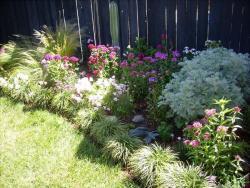
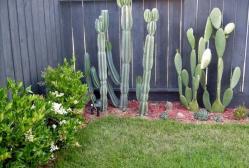
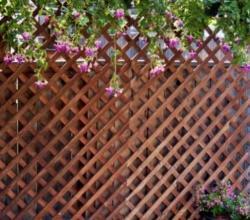
Southern grasses, large herbs, and bi-annual dianthus, to name a few, went in and splashed the yard with color. Larger, zone-appropriate cacti thrived in the same beds that had done in the smaller, more tender ones before. The fuchsia were rescued - I don't know how any made it, but a few survived in a tiny patch of shade provided by the shed - and more were bought in to brighten up our bare porch.
Still, there were more lessons to learn. About half of my new plants were lost from this group, again at the height of summer heat. I finally realized what a challenge we faced. One flowering plant was extremely invasive. Another was supposed to re-seed but did so only slightly; a lot of work to keep it going annually. Yet one more took so much watering that I knew it would not make the grade.
There were also a couple of scary visits to the vet's office, first when one dog inhaled a seed from a large grass plant. The seed was barbed, slipped deeply into his nasal passage, and thus was nearly impossible to dislodge - the sneezing it caused soon turned into blood running from his nose. The other dog got a hold of some of the flowering plants, ate them, and became violently ill. New lessons: check the ASPCA site for plants that are safe for pets! Back to square one ...
RIP - Sweet But Tender, Toxic, or Invasive Lovelies
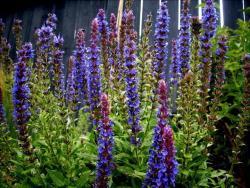
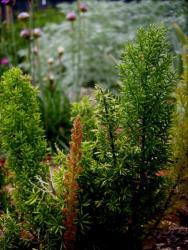

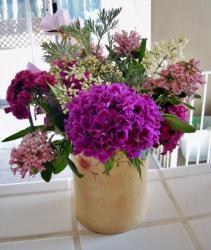

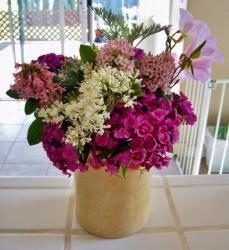
And, then, I found daylilies! They can survive the blast furnace of our yard. And, they are easy to hybridize. Thus, a new hobby has taken hold ....
[ Permalink ]
Unheard of in the heartland, it hadn't occurred to me that an environment left to go arid for five years would have a lot of problems supporting healthy growth - I was just excited to finally have a place to discover the joys of tending a garden and being surrounded by beauty. Such are the joys of initial honeymoon delights. But furrowed brows and wrinkles soon enough set in, and life commences with more lessons to impart.
Hello House!


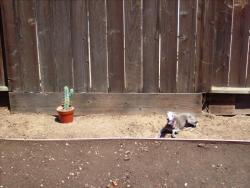
I never knew to flinch as each lesson arrived. Though no one would discern the finer weave of what unfolded, nature quickly showed forth how well connected and influential the environment can be. I trusted the local nurseries to sell what fared well in this area, and was delighted to finally set out a first, rudimentary garden.
The Ground Floor

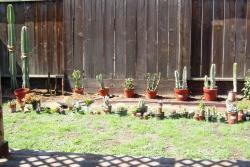

None of these plants were able to thrive long enough to survive a summer in the garden, not even the cacti. I though maybe it was just a lack in planting and grounding techniques. Or, perhaps it was not enough amending, watering and fertilizing. I would soon try again, seeing the same plants offered up at many of the local farms and nurseries. I was convinced that people must really be finding that these lovely recruits could thrive in our 105 degree summers under a withering sun ...
[ Permalink ]
There was never much interest on my part in flowering plants. As a child I only enjoyed the perverse pleasure of popping open Chinese Lanterns and using my fingers to strip the leaves from ferns. Perhaps it was from that inauspicious beginning that I was doomed to develop a decidedly brown thumb, and that would remain very firmly the case for more than 50 years.
Fast forward to 2008 and I was older and wiser, but no closer to any kind of success with plants. I had a tiny house with a big yard in northern Illinois, but with work and my dogs, what little I did for lawn and garden were dwarfed by nature's own broad strokes. Just keeping things mowed and trimmed was more than I could handle in a weekend, so the place always looked overgrown and uninspiring. Fortunately, most of my neighbors were in the same boat.
By February I was getting ready to sell the house and move across country with my two Italian Greyhounds. My then-boyfriend-now-husband (DH) was buying a house we both loved, and I would begin a new life with him in sunny, warm Northern California. My fantasy about that area of the country was that it was always 80 degrees and forever awash with greenery of all types - nothing wouldn't grow in sunny California.
Goodbye house!

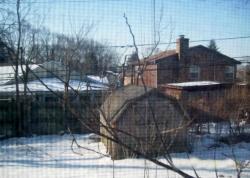

What really excited me was that DH asked me to figure out what to plant in the bare-dirt yard and garden areas behind our home. A fresh chance at gardening redemption and the opportunity to lose the curse of my brown thumb! I had no idea at the time that our house, though approximately in the northern part of California and not more than a couple of hours from S.F., was actually right at the northern tip of the San Joaquin Valley. I'm of the mind that the "Valley" part of the name is a subtle nod to "Death Valley" for how hot and dry the summers are!
[ Permalink ]
This will be my third summer growing daylilies in the flowerbeds around my house. In daylily terms, three years is an average amount of time to progress from seeds to seedlings, then blossoming, pollinating, and setting seed pods. So it seems like just the right time to begin recording a garden diary, to reflect back on a full cycle of growth, and to gather my thoughts about what lies ahead, at the very same moment that I begin to see my own first hybridized seedlings appear. There is a deep gladness in arriving at this destination and finding that it is yet one next step among many in a journey that opens up into an entire life's future - a future filled with the promise of being swept up in marvel at the beauty of a flower that lives only one day. So many unremarkable steps, caught up over time, leading to such a very magical place.
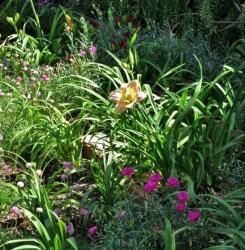
[ Permalink ]